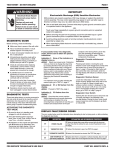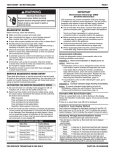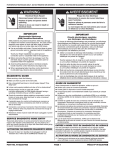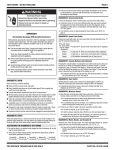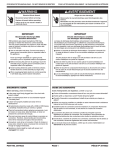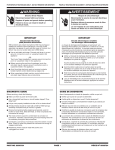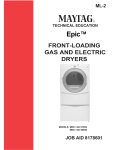Download Whirlpool YWED8300SW2 Troubleshooting guide
Transcript
TECH SHEET - DO NOT DISCARD PAGE 1 WARNING Electrical Shock Hazard Disconnect power before servicing. Replace all parts and panels before operating. Failure to do so can result in death or electrical shock. DIAGNOSTIC GUIDE Before servicing, check the following: ■ Make sure there is power at the wall outlet. ■ Has a household fuse blown or circuit breaker tripped? Time delay fuse? ■ Is dryer vent properly installed and clear of lint or obstructions? ■ All tests/checks should be made with a VOM (volt-ohm-milliammeter) or DVM (digital-voltmeter) having a sensitivity of 20,000 ohms per volt DC or greater. ■ Check all connections before replacing components. Look for broken or loose wires, failed terminals, or wires not pressed into connectors far enough. ■ A potential cause of a control not functioning is corrosion on connections. Observe connections and check for continuity with an ohmmeter. ■ Connectors: Look at top of connector. Check for broken or loose wires. Check for wires not pressed into connector far enough to engage metal barbs. ■ Resistance checks must be made with dryer unplugged or power disconnected. DIAGNOSTIC TESTS These tests allow factory or service personnel to test and verify all inputs to the machine control electronics. You may want to do a quick and overall checkup of the dryer with these tests before going to specific troubleshooting tests. ACTIVATING THE DIAGNOSTIC TEST MODE 1. Be sure the dryer is in standby mode (plugged in with all indicators off, or with only the Cycle Complete indicator on). 2. Select any one button (except PAUSE/CANCEL) and follow the steps below, using the same button (remember the button): Press/hold Release for Press/hold Release for Press/hold ➔ ➔ ➔ ➔ 3 seconds 3 seconds 3 seconds 3 seconds 3 seconds 3. If this test mode has been entered successfully, all indicators on the console are illuminated for 5 seconds with 88 showing in the Estimated Time Remaining two-digit display. If there are no saved fault codes or active fault codes, all indicators on the console will momentarily turn off, then stay on with 88 displayed. DIAGNOSTIC: Unsuccessful Entry If entry into diagnostic mode is unsuccessful, refer to the following indications and actions: Indication 1: None of the indicators or display turns on. Action: Select any cycle. ➔ If indicators come on, try to change the function for the button used to activate the diagnostic test mode. If that FOR SERVICE TECHNICIAN’S USE ONLY IMPORTANT Electrostatic Discharge (ESD) Sensitive Electronics ESD problems are present everywhere. ESD may damage or weaken the machine control electronics. The new control assembly may appear to work well after repair is finished, but failure may occur at a later date due to ESD stress. ■ Use an anti-static wrist strap. Connect wrist strap to green ground connection point or unpainted metal in the appliance -ORTouch your finger repeatedly to a green ground connection point or unpainted metal in the appliance. ■ Before removing the part from its package, touch the anti-static bag to a green ground connection point or unpainted metal in the appliance. ■ Avoid touching electronic parts or terminal contacts; handle machine control electronics by edges only. ■ When repackaging failed machine control electronics in anti-static bag, observe above instructions. button fails to change the function, something is faulty with the button, and it is not possible to enter the diagnostic mode. Remove the console electronics and housing assembly. See Accessing & Removing the Electronic Assemblies, page 10. ➔ If no indicators come on after selecting the cycle, go to TEST #1, page 4. Indication 2: Fault code flashes from the display. Action: Review the Display Fault/Error Codes table, page 2, for the recommended procedure. DIAGNOSTIC: Saved Fault Codes If there are saved fault codes, the most recent fault code will alternately show “F-” and “XX” where XX is the fault code, and all the cycle selector indicators flash. Press and release the same button used to activate Diagnostics Repeat Repeat Repeat ➔ beep tone ➔ Second most recent fault code is displayed. ➔ beep tone ➔ Third most recent fault code is displayed. ➔ beep tone ➔ Fourth most recent fault code is displayed. ➔ All indicators momentarily turn off, then stay on. DIAGNOSTIC: Active Fault Codes If there is an active fault code, it will be flashing in the display (the cycle indicators do not flash). Review the Display Fault/Error Codes table, page 2, for the recommended procedure. If there is no active fault code, 88 will be displayed. DIAGNOSTIC: Console Buttons and Indicators Pressing buttons and rotating the cycle selector will turn off the corresponding indicator and sound a beep as shown in figure 1, Console Diagnostics, page 2. Pressing (more time) will toggle the left digit on the display while sounding a beep. Pressing (less time) will toggle the right digit on the display while sounding a beep. If indicators fail to come on and beep after pressing buttons and rotating the cycle selector, go to TEST #5, page 9. PART NO. 8572759 REV. A TECH SHEET - DO NOT DISCARD Power button controls Status indicators below left and the Lock/Unlock Control indicator. PAGE 2 This backlit button controls the right digit but does not toggle off. This backlit button controls the left digit but does not toggle off. This backlit button controls its own indicator. This button controls all indicators above button. Start button turns on dryer. This button controls all indicators above button. Turns off all indicators and exits diagnostic mode. This button controls all indicators above button. Figure 1. Console Diagnostics. will show one of the following Console IDs: DIAGNOSTIC: Door Switch Opening the door should cause a beep and an alphanumeric number to be displayed. Closing the door should cause a beep and 88 to be displayed. 9b, 9C, 9d, 9E, or 9F. While running, press the START button again. The motor and heater will turn off, and the display will show 88. ➔ If none of the Console IDs above are If opening the door fails to cause a beep and an alphanumeric number to be displayed, go to TEST #6, page 9. Contacts Function Start Run displayed, replace the console electronics and housing assembly. See Accessing & Removing the Electronic Assemblies, page 10. DIAGNOSTIC: Moisture Sensor Open the door and locate two metal strips on the face of the lint screen housing. Bridge these strips with a wet cloth or a finger. If a beep is heard and an alphanumeric number is displayed on the console, the sensor is OK. If not, or if a beep tone is heard before bridging the moisture strips, go to TEST #4, page 8. DIAGNOSTIC: Motor, Heater, and Console ID 1M 2M 3M 5M 6M = Contacts closed Centrifugal Switch (Motor) ➔ If the motor does not turn on, go to TEST #2, page 5. ➔ If no heat is detected, go to TEST #3, page 6. DEACTIVATING THE DIAGNOSTIC TEST MODE Blue-White (Elec) Lt. Blue White (Gas) Green-Yellow Black-White Press the PAUSE/CANCEL button to exit diagnostics. Red Red Close the door. Press the START button. The motor and heater will turn on, and the display DISPLAY FAULT/ERROR CODES The fault codes below would be indicated when attempting to start a drying cycle, or after activating the diagnostic test mode. DISPLAY DESCRIPTION PF Power Failure F-01 Primary Control Failure F-02 Keypad/User Interface Failure PF flashes to indicate that a power failure occurred while the dryer was running. Press START to continue the cycle, or press PAUSE/CANCEL to clear the display. F-01 flashes when there is a primary control failure. Replace the machine control electronics. See Accessing & Removing the Electronic Assemblies, page 10. F-02 flashes when there is a stuck button or user interface mismatch. This fault code will ONLY appear when in the diagnostic test mode. See TEST #5, page 9. F-22 Exhaust Thermistor Open F-22 flashes if the thermistor is open. See TEST #3a, page 7. EXPLANATION AND RECOMMENDED PROCEDURE F-23 Exhaust Thermistor Shorted F-23 flashes if the thermistor has shorted. See TEST #3a, page 7. F-26 Motor Drive System Failure F-26 flashes if there is a motor drive system failure. See TEST #2, page 5. F-28 Moisture Sensor Open F-29 Moisture Sensor Shorted Pluggable Drive Motor Switch F-28 flashes if the moisture sensor strip is open. This fault code will ONLY appear when in the diagnostic test mode. See TEST #4, page 8. F-29 flashes if the moisture sensor strip has shorted. This fault code will ONLY appear when in the diagnostic test mode. See TEST #4, page 8. FOR SERVICE TECHNICIAN’S USE ONLY Black White Blue WHITE White Blue Gas Valve, Gas Dryer PART NO. 8572759 REV. A TECH SHEET - DO NOT DISCARD PAGE 3 ELECTRIC DRYER WIRING DIAGRAM IMPORTANT: Electrostatic (static electricity) discharge may cause damage to machine control electronics. See page 1 for details. L1 LINE – BK R – LINE L2 240 VOLTS W – NEUTRAL N 120 VOLTS BK BK DRUM LAMP P9-2 LAMP (N.C.) L1 DOOR CONSOLE ELECTRONICS NEUTRAL TERMINAL LINKED TO CABINET BR VDD P1-8 DATA IN P1-7 VSS P1-6 STROBE P1-5 DATA OUT P1-4 CLOCK P1-3 BUZZER P1-2 +/- 12 VDC P1-1 P5-1 VDD P5-2 DATA IN P5-3 VSS P5-4 STROBE P5-5 DATA OUT P5-6 CLOCK P5-7 BUZZER P5-8 +/- 12 VDC P2-1 VDD P2-2 DATA P2-3 VSS N.O. BK R COM NEUTRAL MOTOR MTR CS GND MOIST. P8-1 W P8-4 T P8-3 NEUTRAL LBU P8-5 BK-W MOIST RTN MODEL MODEL RTN HEATER RTN EXHAUST TEMP. EXHAUST TEMP RTN N.C. N.C. P13-2 G-Y P14-4 P14-5 Y-R 4M Y-R Y-R SENSOR MOVS HEATER RELAY 1 HEATER +V 5M THERMAL FUSE 196°F (91°C) P8-2 G-Y P13-1 BU-W LBU P9-1 W DOOR SWITCH W R BELT SWITCH 2M CENTRIFUGAL SWITCH MAIN 2.4–3.6 Ω START 2.4–3.8 Ω G-Y 3M 6M 1M DRIVE MOTOR 1/3 H.P. SENSOR BK P14-3 R-W EXHAUST THERMISTOR P14-6 R-W 10k Ω P14-1 P14-2 MACHINE CONTROL ELECTRONICS NC R R-W BK R HI LIMIT THERMOSTAT 295°F (146°C) THERMAL CUT-OFF 352°F (178°C) HEATER 7.8–11.8 Ω GAS DRYER WIRING DIAGRAM L1 LINE – BK W – NEUTRAL N 120 VOLTS BK BR DRUM LAMP BK P9-2 LAMP (N.C.) DOOR L1 NEUTRAL CONSOLE ELECTRONICS VDD P1-8 DATA IN P1-7 VSS P1-6 STROBE P1-5 DATA OUT P1-4 CLOCK P1-3 BUZZER P1-2 +/- 12 VDC P1-1 P5-1 VDD P5-2 DATA IN P5-3 VSS P5-4 STROBE P5-5 DATA OUT P5-6 CLOCK P5-7 BUZZER P5-8 +/- 12 VDC P2-1 VDD P2-2 DATA P2-3 VSS BK N.O. COM MOTOR MTR CS GND MOIST. HEATER RTN R W T P8-3 NEUTRAL P9-1 LBU P8-5 BK-W DOOR SWITCH W LBU R W P8-2 G-Y MODEL MODEL RTN EXHAUST TEMP. EXHAUST TEMP RTN P13-2 G-Y P14-4 Y-R P14-5 O P14-3 R-W P14-6 R-W 5M Y-R Y-R P13-1 4M SENSOR MOVS MOIST RTN HEATER RELAY 1 HEATER +V P8-1 P8-4 SENSOR BELT SWITCH P14-1 N.C. P14-2 3M 1M 6M DRIVE MOTOR 1/3 H.P. BK R EXHAUST THERMISTOR 10k Ω IG IGR IGNITOR 50–500 Ω VALVE MOV 1 2 HOLD MACHINE CONTROL ELECTRONICS NC TF1 TF2 THERMAL FUSE 196°F (91°C) FOR SERVICE TECHNICIAN’S USE ONLY G-Y 1V N.C. R 2M CENTRIFUGAL SWITCH MAIN 2.4–3.6 Ω START 2.4–3.8 Ω R 4 BU HS1 HI LIMIT THERMOSTAT 205°F (96°C) HS2 VALVE NO. 1 5 MAIN 3V R 3 ASSIST FS1 VALVE NO. 2 FS2 FLAME SENSOR PART NO. 8572759 REV. A TECH SHEET - DO NOT DISCARD TROUBLESHOOTING GUIDE PAGE 4 Some tests will require accessing components. See figure 2 for component locations. PROBLEM POSSIBLE CAUSE / TEST NOTE: Possible Cause/Tests MUST be performed in the sequence shown for each problem. 1. Supply connections. See TEST #1 at right. WON’T POWER UP. (No response when buttons are 2. Check harness connections. pressed.) 3. Console electronics and housing assembly. See TEST #5, page 9. 1. If number display flashes, check to be sure the door is completely shut, and press and hold down START for about 1 second. WON’T START CYCLE WHEN START BUTTON IS PRESSED. 2. See TEST #2, page 5. 3. See TEST #6, page 9. 1. Check PAUSE/CANCEL button. See TEST #5, page 9. WON’T SHUT OFF WHEN 2. Console electronics and housing assembly. See TEST #5, page 9. EXPECTED. 3. Moisture sensor. See TEST #4, page 8. CONTROL WON’T ACCEPT SELECTIONS. Console electronics and housing assembly. See TEST #5, page 9. WON’T HEAT. 1. Heater. See TEST #3, page 6. 2. Check harness connections. 3. Check installation. HEATS IN AIR CYCLE. Heater. See TEST #3, page 6. SHUTS OFF BEFORE CLOTHES ARE DRY. 1. 2. 3. 4. 5. TROUBLESHOOTING TESTS NOTE: These checks are done with the dryer unplugged or disconnected from power. TEST #1 Supply Connections This test assumes that proper voltage is present at the outlet, and visual inspection indicates that the power cord is securely fastened to the terminal block (electric dryer) or wire harness connection (gas dryer). Remove Screw Cover Plate Check the dryness setting for auto cycles. Check for full lint screen. Check for clogged vent. Moisture sensor. See TEST #4, page 8. Dryness adjust. See TEST #4a, page 9. Figure 3. Remove the cover plate. ELECTRIC DRYER: 1. Unplug dryer or disconnect power. See Accessing & Removing the Electronic Assemblies, page 10, to access: ■ Machine Control Electronics See Removing the Back ■ Console Electronics Panel, page 11, to access: and Housing ■ Drum Light Assembly ■ Blower Motor Assembly 2. Remove the cover plate from the top right corner of the back of the dryer. See figure 3. 3. With an ohmmeter, check for continuity between the neutral (N) terminal of the plug and the center contact on the terminal block. See figure 4. ➔ If there is no continuity, replace the power cord and test the dryer. ➔ If there is continuity, go to step 4. Door Switch 4. In a similar way, check which terminal of the plug is connected to the left-most contact on the terminal block and make a note of it. This will be L1 (black wire) in the wiring diagram. See figure 4. N Power Cord Plug L1 Terminal Block COM See Removing the Toe Panel, page 10, to access: ■ Moisture Sensors ■ Exhaust Thermistor ■ Thermal Cut-off ■ High Limit Thermostat ■ Heater Assembly (Electric or Gas) ■ Thermal Fuse Figure 4. Plug-to-terminal connections for electric dryer. Heater Assembly Moisture Sensor Strips ➔ When this is found, go to step 5. ➔ If neither of the plug terminals have continuity with the left-most contact of the terminal block, replace the power cord and test the dryer. Figure 2. Component locations. FOR SERVICE TECHNICIAN’S USE ONLY PART NO. 8572759 REV. A TECH SHEET - DO NOT DISCARD PAGE 5 5. Access the machine control electronics without disconnecting any wiring to the control board. See Accessing & Removing the Electronic Assemblies, page 10. 9. Visually check that the console electronics and housing assembly is properly inserted into the front console. Wire Harness 10. If both visual checks pass, replace the console electronics and housing assembly. 6. With an ohmmeter, check for continuity between the L1 terminal of the plug (found in step 4) and P9-2 (black wire) on the machine control board. See figure 17, page 10. 11. Plug in dryer or reconnect power. 12. Perform the Console Buttons and Indicators Diagnostic test, page 1 to verify repair. ➔ If there is continuity, go to step 7. ➔ If there is no continuity, check that wires to the terminal block are mechanically secure. If so, replace the main wire harness and test the dryer. 7. Check for continuity between the neutral (N) terminal of the plug and P8-3 (white wire) on the machine control board. ➔ If there is continuity, go to step 8. ➔ If there is no continuity and the mechanical connections of the wire are secure, replace the main wire harness. Power Cord Figure 5. Power cord-to-wire harness connection for gas dryer. 5. With an ohmmeter, check for continuity between the neutral (N) terminal of the plug and P8-3 (white wire) on the machine control board. The left-hand side of figure 6 shows the position of the neutral terminal (N) on the power cord plug. Also see figure 17, page 10. ➔ If there is continuity, go to step 6. ➔ If there is no continuity, disconnect the white wire of the harness from the power cord at the location illustrated in figure 5. Test the continuity of the power cord neutral wire as illustrated in figure 6. If an open circuit is found, replace the power cord. Otherwise, go to step 6. 9. Visually check that the console electronics and housing assembly is properly inserted into the front console. 10. If both visual checks pass, replace the console electronics and housing assembly. 11. Plug in dryer or reconnect power. Power Cord Plug N L1 12. Perform the Console Buttons and Indicators Diagnostic test, page 1 to verify repair. 13. If indicators still do not light, the machine control electronics has failed: ➔ Plug in dryer or reconnect power. ➔ Perform the Console Buttons and Indicators Diagnostic test, page 1 to verify repair. L1 G Figure 6. Power cord terminals, gas dryer. 6. In a similar way, check the continuity between the L1 terminal of the plug and P9-2 (black wire) on the control board. GAS DRYER: ➔ If there is continuity, go to step 8. 1. Unplug dryer or disconnect power. ➔ If there is no continuity, check the continuity of the power cord in a similar way to that illustrated in figure 6, but for power cord’s L1 wire. 3. Check that the power cord is firmly connected to the dryer’s wire harness. See figure 5. ➔ If an open circuit is found, replace the power cord. Otherwise, go to step 7. 7. Replace the main harness. 8. Visually check that the P5 connector is inserted all the way into the machine control electronics. FOR SERVICE TECHNICIAN’S USE ONLY ➔ Plug in dryer or reconnect power. ➔ Perform the Console Buttons and Indicators Diagnostic test, page 1 to verify repair. TEST #2 Motor Circuit This test will check the wiring to the motor and the motor itself. The following items are part of this motor system: Part of Motor System Harness/connection Thermal fuse Belt/belt switch Drive Motor Centrifugal switch Machine control electronics. See ESD information, page 1. COM N 2. Remove the cover plate from the top right corner of the back of the dryer. See figure 3, page 4. electronics. Door switch G ➔ Unplug dryer or disconnect power. electronics. ➔ Unplug dryer or disconnect power. ➔ Replace the machine control 4. Access the machine control electronics without disconnecting any wiring to the control board. See figure 16, page 10. 8. Visually check that the P5 connector is inserted all the way into the machine control electronics. ➔ Replace the machine control 13. If indicators still do not light, the machine control electronics has failed: Electric Gas Dryer Dryer ✔ ✔ ✔ ✔ ✔ ✔ ✔ ✔ no ✔ ✔ ✔ ✔ ✔ 1. Unplug dryer or disconnect power. 2. Access the machine control electronics and measure the resistance across P8-4 and P9-1. See Accessing & Removing the Electronic Assemblies, page 10. ➔ If resistance across P8-4 and P9-1 is in the range of 1 to 6 ohms, replace the machine control electronics. ➔ Otherwise, go to step 3. 3. Check the wiring and components in the path between these measurement points by referring to the appropriate wiring diagram (gas or electric) on page 3. ELECTRIC DRYER ONLY: Check the thermal fuse. See TEST #3b, page 8. ALL DRYERS: Continue with step 4, following on page 6, to test the remaining components in the motor circuit. PART NO. 8572759 REV. A TECH SHEET - DO NOT DISCARD 4. Check the belt switch and drive motor. Access the belt switch and drive motor by removing the back panel. See Removing the Back Panel, page 11. Slowly remove the drum belt from the spring-loaded belt switch pulley, gently letting the belt switch pulley down. See figure 7. PAGE 6 NOTE: Main and Start winding coils must be checked at the motor. Resistance Contact Points of Measurement MAIN 2.4–3.6 Ω Lt. blue wire in back at pin 4 and bare copper wire on pin 5 of black drive motor switch START 2.4–3.8 Ω Lt. blue wire in back at pin 4 and bare copper wire on pin 3 of black drive motor switch Winding Belt Switch Pulley ➔ If the resistance at the motor is correct, there is an open circuit between the motor and machine control electronics. Check for failed belt switch. Drum Belt ➔ If the Start winding is in question and the resistance is much greater than 4 ohms, replace the motor. Figure 7. Slowly remove drum belt. 5. Remove the white connector from the drive motor switch. See figure 8. 7. Check the belt switch by measuring resistance between the two light blue wires, as shown in figure 10, while pushing up the belt switch pulley. Drive Motor Switch White Connector TEST #3 Heater This test is performed when either of the following situations occur: ✔ Dryer does not heat ✔ Heat will not shut off This test checks the components making up the heating circuit. The following items are part of this system: Part of Heating System Harness/connection Heater relay Thermal cut-off Thermal fuse High limit thermostat Heat element assembly Gas burner assembly Centrifugal switch Exhaust thermistor Machine control electronics. See ESD information, page 1. Console electronics and housing assembly Gas supply Electric Gas Dryer Dryer ✔ ✔ ✔ no ✔ ✔ no ✔ ✔ ✔ ✔ ✔ ✔ ✔ ✔ no ✔ ✔ ✔ ✔ ✔ ✔ no ✔ 1 Locate the components using figure 11, page 7. 5 26 4 3 Lt. Blue Wires 26 4 3 5 1 Dryer does not heat: ELECTRIC DRYER: 1. Unplug dryer or disconnect power. 2. Remove the toe panel to access the thermal components. See figure 14, page 10. Figure 8. Remove white connector. Belt Switch Pulley Belt Switch Figure 10. Checking the belt switch. Main Winding: Lt. Blue Wire in Back and Bare Copper Wire ➔ If the resistance reading goes from infinity to a few ohms as pulley arm closes the switch, belt switch is OK. If not, replace the belt switch. 1 an open circuit, check and repair the wiring harness. 5 26 4 3 Start Winding: Lt. Blue Wire in Back and Bare Copper Wire ➔ If belt switch is OK and there is still Figure 9. Main and start winding measure points. 8. Door Switch problems can be uncovered in the Door Switch Diagnostic Test, page 2; however, if this was not done, the following can be done without applying power to the dryer. Connect an ohmmeter across P8-3 (neutral, white wire) and P8-4 (door, tan wire). 6. Using figure 9, check for the resistance values of the motor’s Main and Start winding coils as shown in the following table. FOR SERVICE TECHNICIAN’S USE ONLY ➔ With the door properly closed, the ohmmeter should indicate a closed circuit (0–2 ohms). ➔ If not, replace the door switch assembly. 3. Using an ohmmeter and referring to the wiring diagram, measure the resistance from the red wire terminal at the thermal cut-off to the red wire terminal at the heater. ➔ If the resistance is about 10 ohms, go to step 5. ➔ If an open circuit is detected, go to step 4. 4. Visually check the wire connections to the thermal cut-off, high limit thermostat, and heater. If connections look good, check for continuity across each of these components. ➔ Replace the heater if it is electrically open. ➔ Replace both the thermal cut-off and high limit thermostat if either one is electrically open. 5. If no open circuit is detected, remove the P14 connector, then measure the resistance between P14-3 (red-white wire) and P14-6 (red-white wire) at the connector. See figure 17, page 10 for connector location; and Accessing & PART NO. 8572759 REV. A TECH SHEET - DO NOT DISCARD PAGE 7 Heater Element Thermal Cut-Off High Limit Thermostat Thermal Cut-Off Flame Sensor High Limit Thermostat Thermal Fuse Thermal Fuse Exhaust Thermistor Exhaust Thermistor Electric Dryer Gas Dryer Figure 11. Thermal Components, viewed from front. Removing the Electronic Assemblies, page 10. (red-white wire) and P14-6 (red-white wire) at the connector. See figure 17, page 10 for connector location; and Accessing & Removing the Electronic Assemblies, page 10. ➔ If 5–15 k ohms are measured, replace the machine control electronics. ➔ If the resistance is less than 1 k ohm, ➔ If 5–15 k ohms are measured, replace the exhaust thermistor. replace the machine control electronics. GAS DRYER: 1. Unplug dryer or disconnect power. ➔ If the resistance is greater than 20 k ohms, replace the exhaust thermistor. 2. Remove the toe panel to access the thermal components. See figure 14, page 10. 3. Perform TEST #3b, page 8. If the thermal fuse is OK, go to step 4. 4. Perform TEST #3c, page 8. If the thermal cut-off is OK, go to step 5. 5. Locate the high limit thermostat. See figure 11. Measure the continuity through it by connecting the meter probes on the red wire and blue wire terminals. ➔ If there is an open circuit, replace the high limit thermostat and thermal cut-off. ➔ Otherwise, go to step 6. 6. Perform TEST #3d, page 8. If this is OK, replace the machine control electronics. TEST #3a Exhaust Thermistor The machine control electronics monitors the exhaust temperature using the exhaust thermistor, and cycles the heater relay on and off to maintain the desired temperature. Begin with an empty dryer and a clean lint screen. 1. Plug in dryer or reconnect power. 2. Start the Timed Dry cycle. 3. If after 60 seconds, F-22 or F-23 flashes in the display and the dryer shuts off, the thermistor or wire harness is either open or shorted. Heat will not shut off: 1. Unplug dryer or disconnect power. 2. Access the machine control electronics. Remove the P14 connector, then measure the resistance between P14-3 FOR SERVICE TECHNICIAN’S USE ONLY ➔ If wire connections are good, remove the two wires from the thermistor and replace the thermistor. ➔ Plug in dryer or reconnect power. 4. If F-22 or F-23 does not flash in the display, the connections to the thermistor are good. Therefore, check the exhaust temperature value at any or all of the temperature levels in question, using the Timed Dry cycle, and the following process: Hold a glass bulb thermometer capable of reading from 90° to 180°F (32° to 82°C) in the center of the exhaust outlet. The correct exhaust temperatures are as follows: EXHAUST TEMPERATURES TEMPERATURE SETTING High 155° ± 5°F (68° ± 3°C) Medium 140° ± 5°F (60° ± 3°C) Low 125° ± 5°F (52° ± 3°C) Extra Low 115° ± 5°F (46° ± 3°C) ➔ Unplug dryer or disconnect power. ➔ Check wire connections at the machine control electronics and thermistor. See Accessing & Removing the Electronic Assemblies on page 10, and for thermistor location see figure 11. HEAT TURNS HEAT TURNS OFF* ON 10–15°F (6–8°C) below the heat turn off temperature * The measured overshoot using the glass bulb thermometer in the exhaust outlet can be 30°F (17°C) higher. PART NO. 8572759 REV. A TECH SHEET - DO NOT DISCARD 5. If the exhaust temperature is not within specified limits, remove the P14 connector, then measure the resistance between P14-3 (red-white wire) and P14-6 (red-white wire) at the connector. See figure 17, page 10 for connector location; and Accessing & Removing the Electronic Assemblies, page 10. NOTE: All thermistor resistance measurements must be made while dryer is unplugged or disconnected from power. The following table gives temperatures and their associated resistance values. EXHAUST THERMISTOR RESISTANCE TEMP. °F (°C) RES. kΩ TEMP. °F (°C) RES. kΩ 50° (10°) 19.0–22.0 80° (27°) 8.5–10.5 60° (16°) 14.8–16.8 90° (32°) 6.8–8.8 70° (21°) 11.5–13.5 100° (38°) 5.0–7.0 PAGE 8 ➔ If the ohmmeter indicates an open circuit, replace the failed thermal cut-off and high limit thermostat. In addition, check for blocked or improper exhaust system, or failed heat element (electric dryer). TEST #3d Gas Valve, Gas Dryer Only 2. Access the gas valve by removing the toe panel. See Removing the Toe Panel, page 10. TEST #3b Thermal Fuse ELECTRIC DRYER: The thermal fuse is wired in series with the dryer drive motor. GAS DRYER: The thermal fuse is wired in series with the dryer gas valve. ALL DRYERS: 1. Unplug dryer or disconnect power. 2. Access the thermal fuse by first removing the toe panel. See Removing the Toe Panel, page 10; and for thermal fuse location see figure 11, page 7. 3. Using an ohmmeter, check the continuity across the thermal fuse. See figure 11 for location. ➔ If the ohmmeter indicates an open circuit, replace the failed thermal fuse. TEST #3c Thermal Cut-Off If the dryer does not produce heat, check the status of the thermal cut-off. 1. Unplug dryer or disconnect power. 2. Access the thermal cut-off by first removing the toe panel. See Removing the Toe Panel, page 10. 4. Access the moisture sensor wires by removing the toe panel. See Removing the Toe Panel, page 10. Disconnect the sensor wires from the harness. See figure 12. Drum 3. Use an ohmmeter to determine if a gas valve coil has failed. Remove harness plugs. Measure resistance across terminals. Readings should match those shown in the following chart. If not, replace coil. FRONT Terminals Resistance 1 to 2 1 to 3 4 to 5 agree with table, replace the exhaust thermistor. agree with the measurements in the table, replace the machine control electronics. NOTE: Over drying may be caused by a short circuit in the sensor system. 1. Unplug dryer or disconnect power. ➔ If the thermistor resistance does not ➔ If the thermistor resistance checks before bridging the moisture strips, continue with step 4. 1365Ω ± 25 560Ω ± 25 1220Ω ± 50 IMPORTANT: Be sure all harness wires are looped back through the strain relief after checking or replacing coils. TEST #4 Moisture Sensor NOTE: This test is started with the machine completely assembled. This test is performed when an automatic cycle stops too soon, or runs much longer than expected. NOTE: Dryer will shut down automatically after 2½ hours. The following items are part of this system: Harness/connection Metal sensor strips Machine control electronics. See ESD information, page 1. 1. Activate the diagnostic test mode and advance past saved fault codes. See procedure on page 1. 2. Open the dryer door. The dryer will beep and an alphanumeric number will be displayed. 3. Locate the two metal sensor strips on the face of the lint screen housing. Bridge these strips with a wet cloth or finger. 3. Using an ohmmeter, check the continuity across the thermal cut-off. See figure 11, page 7 for location. ➔ If a beep tone is heard and an alphanumeric number is displayed on the console, the sensor passes the test. Go to step 9. MOVs (Metal Oxide Varistors) Harness Connection Blower Housing Figure 12. Disconnect sensor from wire harness. 5. Access the machine control electronics. See Accessing & Removing the Electronic Assemblies, page 10. Remove connector P13 from the circuit board. Check the main harness connections between the sensor harness and machine control for a short or open circuit. ➔ Replace the main harness if necessary. ➔ If harness is OK, continue with step 6. 6. Access the moisture sensor by removing the toe panel. See Removing the Toe Panel, page 10. Disconnect the sensor from the wire harness. See figure 12. 7. Measure the resistance across the outermost contacts of the cable that includes the two red MOVs. ➔ If a small resistance is measured, check for debris across moisture strips inside of the drum; clean if debris is present. If debris is not present, replace sensor harness. ➔ If a small resistance is not measured, continue with step 8. ➔ If a beep tone is not heard, or a continuous beep tone is heard FOR SERVICE TECHNICIAN’S USE ONLY PART NO. 8572759 REV. A TECH SHEET - DO NOT DISCARD 8. Measure the resistance across each of the outermost contacts and the center terminal (ground connection). ➔ If a resistance less than infinity is measured, replace the sensor harness. PAGE 9 TEST #5 Buttons and Indicators This test is performed when any of the following situations occurs during the Console Buttons and Indicators Diagnostic Test, page 1: ✔ None of the indicators light up 9. If moisture sensor diagnostic test passes, check the thermistor: Perform TEST #3a, page 7. ✔ No beep sound is heard ✔ Some buttons do not light ➔ If the problem persists after replacing the moisture sensor and thermistor, replace the machine control electronics. TEST #4a Adjusting Customer-Focused Drying Modes NOTE: If the customer is complaining about the clothes being damp and the moisture sensor passes TEST #4, step 3, the total dry time can be lengthened by changing from a “1” (standard auto cycle) to a “2” (15% more drying time) or “3” (30% more drying time) auto cycle. 1. Activate the diagnostic test mode, and advance past saved fault codes. See Activating the Diagnostic Test Mode, page 1. 2. In diagnostic test mode, press and hold the Dryness button for 5 seconds. The dryer will beep and the current drying mode will be seen on the display. The factory default value is “1”. 3. To select a different drying mode, press the Dryness button again. The dryer display will flash and show 2, 3, or 1. 4. With the display flashing the selected auto cycle mode, press the START button to save the drying mode and exit diagnostics (the START button in this mode does not start a drying cycle). The result will be stored in EEPROM of the control board, and will be retained after a power loss. 5. Press the PAUSE/CANCEL button at any time to cancel changes and exit from this mode. indicators None of the indicators light up: 1. See Diagnostic Guide/Before Servicing... on page 1. 2. Perform Test #1, page 4 to verify supply connections. 3. Perform steps in Accessing and Removing the Electronic Assemblies, page 10 and visually check that the P5 connector is inserted all the way into the machine control electronics. 4. Visually check that the console electronics and housing assembly is properly inserted into the front console. 5. If both visual checks pass, replace the console electronics and housing assembly. 6. Plug in dryer or reconnect power. 7. Perform the Console Buttons and Indicators Diagnostic test, page 1 to verify repair. 8. If indicators still do not light, the machine control electronics has failed: ➔ Unplug dryer or disconnect power. ➔ Replace the machine control electronics. ➔ Plug in dryer or reconnect power. ➔ Plug in dryer or reconnect power. ➔ Perform the Console Buttons and Indicators Diagnostic test, page 1 to verify repair. Some buttons do not light indicators: 1. Perform steps in Accessing and Removing the Electronic Assemblies, page 10 and visually check that the console electronics and housing assembly is properly inserted into the front console. ➔ If visual check passes, replace the console electronics and housing assembly. 2. Plug in dryer or reconnect power. 3. Perform the Console Buttons and Indicators Diagnostics test, page 1 to verify repair. TEST #6 Door Switch Activate the diagnostic test mode as shown on page 1, and perform the Door Switch Diagnostic test, page 2. Functionality is verified with a beep each time the door is closed and opened, and an alphanumeric number appears in the display (i.e., 0E, 09). If any of the above conditions are not met, or if one of the dryer model codes listed above is displayed when the door is closed: ➔ Unplug dryer or disconnect power. ➔ Check that the wires between the door switch and machine control electronics are connected. See figure 13 for switch location, and see Accessing and Removing the Electronic Assemblies, page 10. ➔ Perform the Console Buttons and Indicators Diagnostic test, page 1 to verify repair. No beep sound is heard: Door Switch 1. Perform steps in Accessing and Removing the Electronic Assemblies, page 10 and visually check that the P5 connector is inserted all the way into the machine control electronics. ➔ If visual check passes, replace the console electronics and housing assembly. Figure 13. Door switch location. 2. Plug in dryer or reconnect power. 3. Perform the Console Buttons and Indicators Diagnostic test, page 1 to verify repair. ➔ If the connections are OK, replace 4. If replacing the console electronics and housing assembly failed: ➔ If wire and door switch assembly ➔ Unplug dryer or disconnect power. ➔ Replace the machine control the wire and door switch assembly and retest. have been replaced and dryer still does not start, replace the machine control electronics. electronics. FOR SERVICE TECHNICIAN’S USE ONLY PART NO. 8572759 REV. A TECH SHEET - DO NOT DISCARD REMOVING THE TOE PANEL 1. Unplug dryer or disconnect power. 2. Remove two screws below the toe panel. PAGE 10 2. Slide the bracket over the top of the drum to access the machine control electronics connectors and mounting screw. See figure 16. 3. Slide the toe panel down, then pull it out from the bottom. See figure 14. Machine Control Electronics Assembly FRONT Accessing the Console Electronics and Housing Assembly 1. Access the machine control electronics (see Accessing the Machine Control Electronics at left) and disconnect the P5 ribbon cable. 2. The console panel must be removed to access the console electronics and housing assembly. Remove the knob from the front of the console panel. Flange Mounting Screw Figure 14. Pull the toe panel down to clear flange, then pull panel out. ACCESSING & REMOVING THE ELECTRONIC ASSEMBLIES There are two electronic assemblies; the Console Electronics and Housing, and the Machine Control Electronics. See figure 15. 1. Unplug dryer or disconnect power. 2. Remove the two rear screws from the top panel, and slide the top panel to the rear to remove. Machine Control Electronics Assembly the machine control electronics and slide the assembly to the front, then lift. Machine Control Electronics Bracket Figure 16. Remove machine control electronics from mounting bracket. Removing the Machine Control Electronics 1. Remove all the wire connections to the machine control electronics. See figure 17. 3. The console panel has two locking tabs on the left and right rear, one locking tab on the bottom (hidden), and three snap releases across the top. See figure 18. Press the locking tab on the right rear, and gently rotate the console panel up as you pull the top free of the three snap releases, finally pressing the locking tab on the left, and lift the console panel off. Console Electronics and Housing Assembly (inside) Snap Releases 2. Remove the screw holding the machine control electronics assembly to the mounting bracket. See figure 16. 3. There are two plastic legs on the front of the machine control electronics that slide under the mounting bracket. ✔ There is one plastic leg on the rear of the machine control electronics that slides under the mounting bracket. Console Electronics and Housing Assembly (inside) Locking Tabs Figure 18. Remove the console panel to access the console electronics and housing assembly. ✔ There is a locking tab on the bottom of the machine control electronics that snaps into the mounting bracket. Press the locking tab on the bottom of N.O. Heater COM Black Relay 1 Red Lt. Blue Black Motor Relay Yellow-Red P9 1 1 1 FRONT P13 P3 P5 8 Figure 15. Locate the electronic assemblies. 1 P2 P/N XXXXXX Rev X Date CodeYDDD-xx XXXX-XXX MADE IN COO Accessing the Machine Control Electronics 1. After locating the machine control electronics, remove the two screws that hold the machine control electronics bracket in place. 5 1 P8 Black-White Tan White Green-Yellow Open Open 3 P14 1 Red-White 3 6 1 P4 1 Open (Elec.) Orange (Gas) Red-White Figure 17. FOR SERVICE TECHNICIAN’S USE ONLY Machine control electronics. PART NO. 8572759 REV. A TECH SHEET - DO NOT DISCARD PAGE 11 Removing the Console Electronics and Housing Assembly The console electronics and housing assembly is held to the console panel by seven locking tabs. Press each of the locking tabs while gently lifting the console electronics and housing assembly out of the console panel. See figure 19. Console Electronics and Housing Assembly Figure 19. Locate seven locking tabs. REMOVING THE BACK PANEL 1. Unplug dryer or disconnect power. 2. Remove the two rear screws from the top panel, and slide the top panel to the rear to remove. 3. Remove the cover plate, disconnect the power cord, and remove ground screw. 4. Remove the metal spring clip between the back panel and the exhaust outlet. See figure 20. Ground Screw Cover Plate Metal Spring Clip Figure 20. Remove 12 screws. 5. Remove the ten screws on the rear, and two screws on the top of the back panel. Pull the back panel off the machine. See figure 20. ELECTRIC DRYER: In addition to the above, remove the terminal block from the back panel. FOR SERVICE TECHNICIAN’S USE ONLY PART NO. 8572759 REV. A TECH SHEET - DO NOT DISCARD PAGE 12 SOFTWARE COPYRIGHTED. MANUFACTURED UNDER ONE OR MORE OF THE FOLLOWING U.S. PATENTS: 4669200 4700495 4754556 4840285 4865366 4899464 4908959 01/06 FOR SERVICE TECHNICIAN’S USE ONLY 4989347 5066050 5560120 5809828 6020698 6047486 6199300 6446357 6597144 6604298 6685241 6732447 6784673 6819255 D314261 D314262 D457991 D457992 D495453 PART NO. 8572759 REV. A













